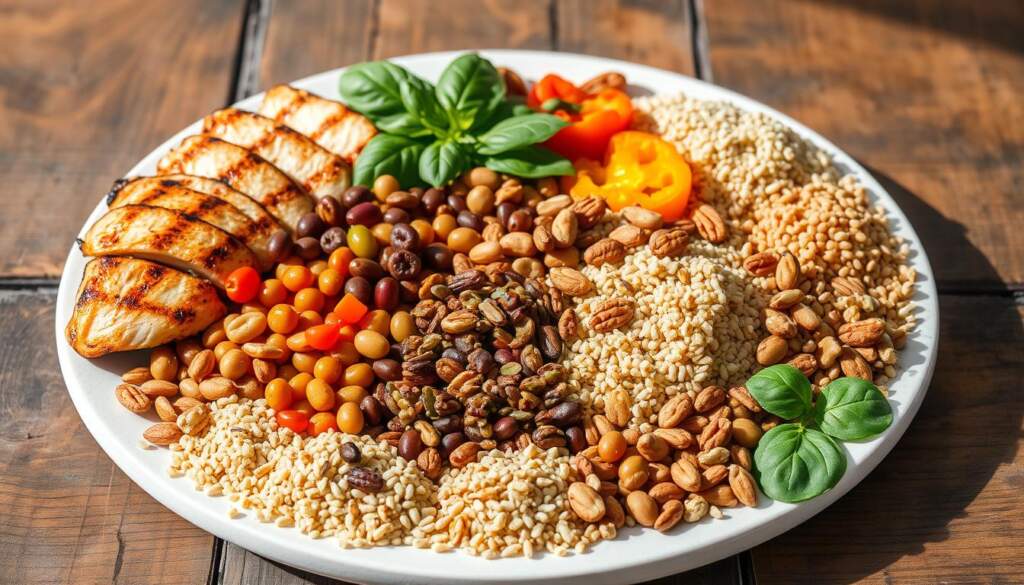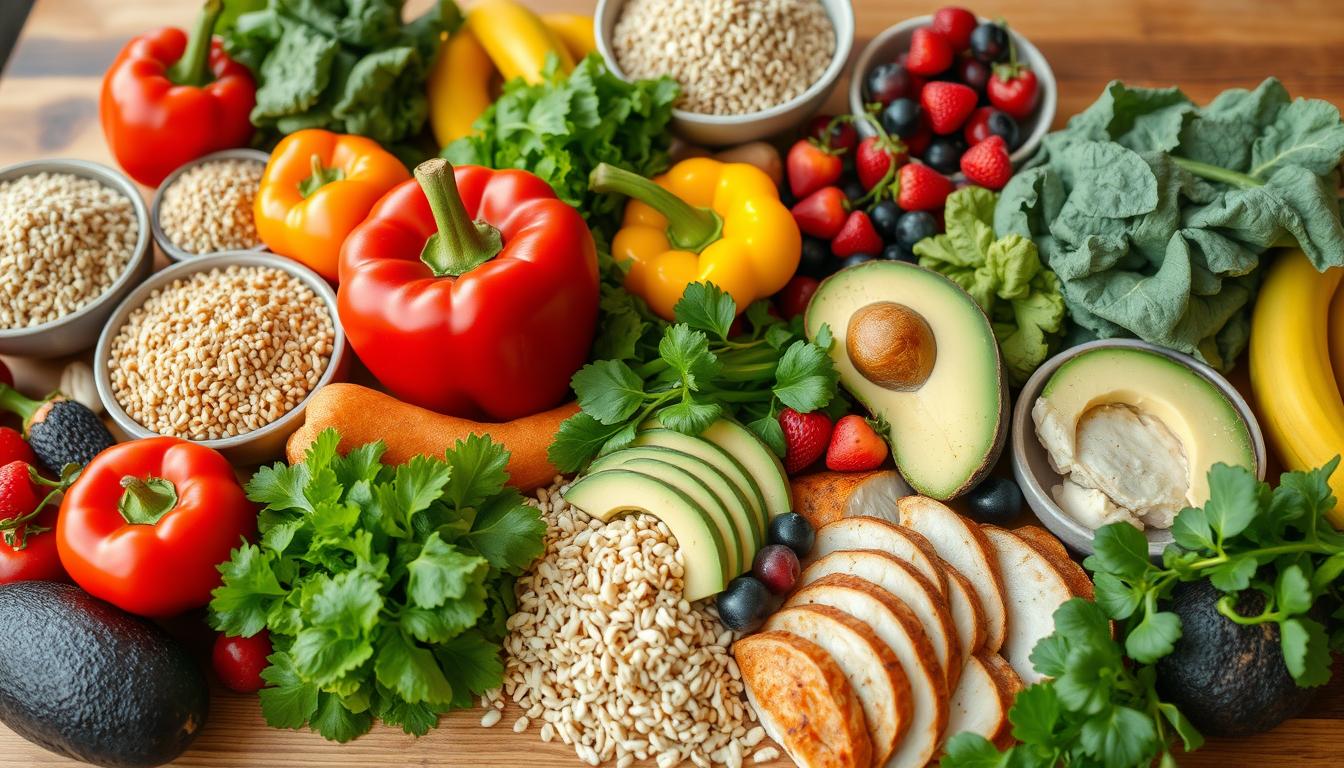Adopting a healthy lifestyle doesn’t have to be a complex challenge. With simple strategies and a focus on a balanced diet, you can unlock the door to lasting wellness. Integrating wholesome practices, such as opting for whole grains, relishing a variety of fruits and vegetables, and monitoring your intake based on energy needs, is a pragmatic road to health success. Men and women have different daily caloric requirements, about 2,500 and 2,000 calories respectively1. This tailored approach ensures that every meal contributes to an overall healthy pattern of eating that is realistic and sustainable.
Key Takeaways
- Embrace simple strategies for a balanced and healthy lifestyle.
- Choose whole grains and sufficient protein to foster lasting wellness.
- Incorporate at least 5 portions of fruits and vegetables each day for optimal health1.
- Monitor caloric intake to align with daily energy requirements of 2,500 for men and 2,000 for women1.
- Understand that healthy eating is a path to longevity, not a fleeting trend.
- Maintain a well-portioned diet and stay hydrated with 6 to 8 glasses of fluids daily1.
Starting Simple: Small Dietary Changes for Lasting Health
When initiating a shift towards healthier eating habits, emphasizing manageable diet changes is crucial. Increasing fruit consumption offers a practical and enjoyable entry point that encourages broader positive dietary behaviors. In fact, incorporating more fruits can kickstart a journey towards chronic disease prevention and overall better health. This straightforward change not only provides significant health benefits but also fosters a sustainable approach to nourishment.
Consider the impact of replacing high-calorie snacks with fruits. Doing so can curb excessive calorie intake subtly and increase the intake of essential vitamins and fiber. Moreover, such tweaks in your diet align well with the preparation stage of behavior change, where making informed choices becomes pivotal in managing health long-term2.
To visualize these changes, imagine adjusting your diet to include more whole grains or opting for reduced-fat alternatives. According to research, simply switching to lower-fat milk for your morning cereal might save you around 160 calories weekly, which can accumulate to substantial calorie savings over time3. Similarly, adopting wholemeal bread introduces more nutrients compared to the standard white variety, enhancing your meal’s nutritional value without sacrificing satisfaction3.
Transitioning to healthier eating doesn’t require drastic measures. Substituting full-fat spreads for their reduced-fat counterparts could save up to 13,000 calories annually, significantly contributing to weight management3. These manageable diet changes, although small, pave the way for considerable health improvements.
To further support these changes, engage in tracking your progress. Monitoring not only helps in maintaining consistency but also in overcoming common roadblocks2. In addition, planning ahead and preparing alternative snacking options plays a critical role in this journey and is a key strategy in maintaining healthy behaviors2.
For more on how small dietary modifications can lead to lasting health enhancements, explore our tailored advice on sustainable diet planning.
By starting simple, you set a foundation for enduring health benefits and a lifelong commitment to well-being. Adopting easy-to-manage, incremental changes not only promotes health but also integrates effortlessly into daily life, proving that effective health management can indeed start with something as simple as improving fruit consumption and making educated food swaps.
The Power of Protein and Whole Grains in Your Diet
Incorporating high-protein meals and whole grains into your daily routine can significantly enhance your health. A diet rich in these elements supports muscle mass retention, stabilizes blood sugar levels, and helps maintain a nutrient-rich diet.

Boosting Satiety with Protein-Rich Foods
Protein is crucial for satiety, helping to reduce cravings and overeating. Consuming a variety of protein sources, such as dairy products, nuts, eggs, beans, and lean meats, throughout the day can play a pivotal role in maintaining energy levels and supporting metabolic processes. This nutrient-dense intake is particularly beneficial for those looking to sustain or increase muscle mass.
Whole Grains Over Refined: A Heartier Choice
Choosing whole grains over refined grains is a smart and healthful decision reflected widely in dietary recommendations. Whole grains, unlike their refined counterparts, retain all the nutrient-rich parts of the grain, helping in the maintenance of blood sugar levels and thereby reducing risks associated with diabetes and heart diseases.
According to the Dietary Guidelines for Americans, most people don’t consume enough whole grains4. It is advised that at least half of all grains consumed be whole grains to benefit from their fiber, vitamins, and minerals that significantly lower the risk of chronic diseases45. For example, individuals consuming at least 2 servings of whole grains daily are much less likely to develop type 2 diabetes6.
| Benefits | Whole Grains | Refined Grains |
|---|---|---|
| Vitamins and Minerals | High (B vitamins, iron, magnesium) | Low |
| Fiber Content | High | Low |
| Risk Reduction | Heart disease, Diabetes, Cancer | N/A |
| Impact on Blood Sugar | Stabilizes | Increases rapidly |
Embracing whole grains not only provides essential nutrients like Vitamin A, B vitamins, and iron but also plays a key role in controlling cholesterol levels and managing weight4. Furthermore, studies have shown that switching from refined grains like white rice to whole grains can significantly reduce the risk of diabetes and other chronic conditions56.
In conclusion, integrating high-protein meals and whole grains into your diet can lead to substantial health benefits, promoting a balanced, nutrient-rich diet that supports overall well-being.
Portion Control: The Path to Mindful Eating
Mindful eating is profoundly influenced by portion management, an essential strategy for fostering reduced energy intake and enhancing overall wellness. It encourages individuals to listen attentively to their body’s satiety signals, preventing overeating and supporting sustainable weight management.
Eat from Smaller Plates for Satisfied Cravings
Utilizing smaller plates can create an illusion of a fuller plate, leading to increased feelings of satisfaction despite a lower volume of food consumed. Research suggests that plate size, shape, and color can significantly affect perceived portion size and attractiveness, potentially influencing our eating behavior7. Furthermore, eating from smaller plates is a practical application of mindfulness, which can substantially reduce the likelihood of overindulging8.
Greens First: A Method to Prioritize Nutrients
Starting meals with a generous portion of vegetables is recommended to ensure that nutrient intake is prioritized. By filling half of one’s plate with vegetables, as suggested by the USDA’s MyPlate guidelines8, individuals are less likely to fill up on less nutritious options. This method not only aligns with mindful eating practices but also helps in reducing overall energy intake.
Slowing Down to Register Fullness
Slowing down the pace at which one eats allows ample time for the brain to receive the crucial satiety signals necessary for regulating appetite. It takes approximately 20 minutes for the body to recognize that it has been fed, a critical reason to pace oneself and avoid rushing through meals8. This habit fosters better digestion and can be a significant factor in achieving a healthy weight.


| Strategy | Benefits | Statistical Data |
|---|---|---|
| Smaller Plates | Increases perceived portion size, enhances food satisfaction | Decreases portion size without compromising satisfaction7 |
| Fruits and Vegetables First | Prioritizes nutrient intake, reduces intake of less healthy foods | Aligns with USDA’s MyPlate guidelines8 |
| Eating Slowly | Allows time for fullness signals, improves digestion | Helps recognize fullness, prevents overeating8 |
Smart Grocery Shopping and Home Cooking
Embarking on the journey to a healthier lifestyle goes beyond making the right choices; it involves intelligent strategies for shopping and cooking that lead to smart, wholesome eating habits. Understanding the grocery list importance
is crucial for avoiding impulse purchases, especially when navigating the outer aisles of the store, where the freshest whole foods like fruits, vegetables, dairy, and proteins await910. By prioritizing these nutrient-rich foods and utilizing sales, coupons, and local produce options, you’ll not only save money but also enhance the nutritional value of your meals9.
Making a Shopping List: Your Blueprint for Healthy Meals
Creating a detailed grocery list is paramount for maintaining focus in-store, ensuring that essential items like whole grains and lean proteins are not forgotten10. Incorporating versatile, cost-effective staples such as beans, brown rice, and oats can lay the foundation for numerous healthy home meals11. This strategy prevents last-minute, hunger-induced decisions that often result in less healthy choices10. Meal planning also emerges as a key element in optimal food utilization, gearing towards a significant reduction in waste and expenses911.
The Pitfalls of Diet Foods and the Benefits of Whole Foods
Avoiding misleading ‘diet’ foods—frequently laden with added sugars—and instead opting for whole foods in their less processed forms can maintain nutritional integrity and benefit one’s health9. This switch not only curbs the inclusion of empty calories but redefines cost-effectiveness by providing nourishment and satiation without breaking the bank9. The benefits of these choices include lower sodium and healthier fat intake, which align with recommendations for a balanced diet10.
Home Cooking: A Foundation for Healthy Living
Home cooking stands as a pillar for controlling ingredients, ensuring the preparation of healthy meals11. Exploring new, health-focused recipes reaffirms cooking habits that prioritize nutrition and variety, fostering an appreciation for the craft over conveniences like fast food. Adopting cooking practices such as using bulk-purchased whole grains, integrating affordable proteins like legumes and eggs, and relishing in the flavors of seasonal produce can make home dining both a delight and a dedication to well-being11. Embrace this transformative affair to realize the full spectrum of a health-conscious lifestyle.
FAQ
How can I begin to develop healthy eating habits without feeling overwhelmed?
What are some small dietary changes I can make for lasting wellness?
How can protein in my diet help with satiety and maintaining a healthy lifestyle?
Why should I choose whole grains over refined grains?
What are some effective strategies for portion control?
How does making a shopping list help contribute to healthy eating habits?
Are diet foods always a healthy choice?
What are the health benefits of home cooking?
Can you suggest a method to reduce calorie intake without feeling hungry?
How can I prevent chronic diseases through dietary choices?
Source Links
- 8 tips for healthy eating – https://www.nhs.uk/live-well/eat-well/how-to-eat-a-balanced-diet/eight-tips-for-healthy-eating/
- Changing Your Habits for Better Health – NIDDK – https://www.niddk.nih.gov/health-information/diet-nutrition/changing-habits-better-health
- 13 small changes that add up to a healthy diet – https://www.bhf.org.uk/informationsupport/heart-matters-magazine/nutrition/small-changes-add-up
- The whole truth about whole grains – https://www.mayoclinic.org/healthy-lifestyle/nutrition-and-healthy-eating/in-depth/whole-grains/art-20047826
- Whole Grains – https://nutritionsource.hsph.harvard.edu/what-should-you-eat/whole-grains/
- 9 Health Benefits of Eating Whole Grains – https://www.healthline.com/nutrition/9-benefits-of-whole-grains
- 9 Tips to Measure and Control Portion Sizes – https://www.healthline.com/nutrition/portion-control
- How Portion Control and Mindful Eating Can Benefit Your Health – https://health.umms.org/2024/05/09/how-portion-control-can-benefit-your-health/
- 19 Ways to Eat Healthy on a Tight Budget – https://www.healthline.com/nutrition/19-ways-to-eat-healthy-on-a-budget
- 9 Grocery Shopping Tips – https://www.heart.org/en/healthy-living/healthy-eating/cooking-skills/shopping/grocery-shopping-tips
- Eat Smart, Spend Less: Guide to a Budget Friendly Healthy Grocery Haul – https://nourishedbynic.com/guide-to-a-budget-friendly-healthy-grocery-haul/



